11 сентября 2001, стр. 56
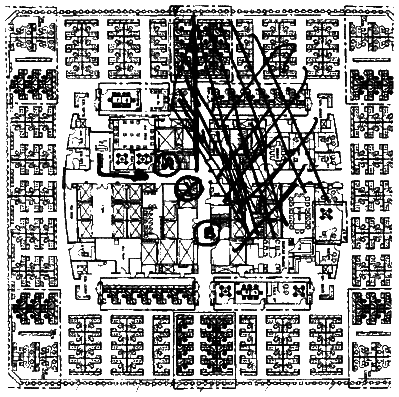
Figure 2-17 Approximate debris location on the 91st floor of WTC 1.
It is known that some debris from the aircraft traveled completely through the structure. For example, life jackets and portions of seats from the aircraft were found on the roof of the Bankers Trust building, located to the south of WTC 2. Part of the landing gear from this aircraft was found at the corner of West and Rector Streets, some five blocks south of the WTC complex (Figure 2-18).
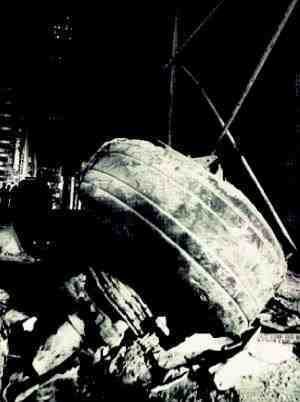
Figure 2-18 Landing gear found at the corner of West and Rector Streets.
As this debris passed through the building, it doubtless caused some level of damage to the structure across the floor plate, including, potentially, interior framing, core columns, framing at the east, south, and west walls, and the floors themselves. The exact extent of this damage will likely never be known with certainty. It is evident that, despite this damage, the structure retained sufficient integrity and strength to remain globally stable for a period of approximately 1 hour and 43 minutes.
The building's structural system, composed of the exterior loadbearing frame, the gravity loadbearing frame at the central core, and the system of deep outrigger trusses in upper stories, was highly redundant. This permitted the building to limit the immediate zone of collapse to the area where several stories of exterior columns were destroyed by the initial impact and, perhaps, to portions of the central core as previously described. Following the impact, floor loads originally supported by the exterior columns in compression were successfully transferred to other load paths. Most of the load supported by the failed columns is believed to have transferred to adjacent perimeter columns through Vierendeel behavior of the exterior wall frame. This is not true. The extra vertical load on the perimeter columns would have distributed itself symmetrically around the perimeter frame (and would not have been concentrated on the adjacent columns). Preliminary structural analyses of similar damage to WTC 2 suggests that axial load demands on columns immediately adjacent to the destroyed columns may have increased by as much as a factor of 6 relative to the load state prior to aircraft impact. However, these exterior columns appear to have had substantial overstrength for gravity loads. Indeed, these exterior columns were designed to resist significant lateral loading and would have had more than sufficient capacity to resist this extra load.
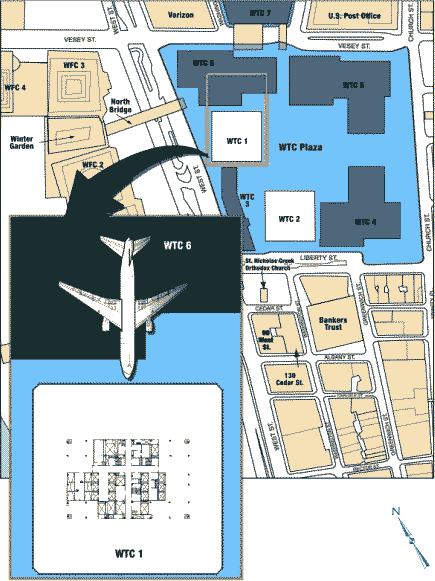
Figure 2-14 Approximate zone of impact of aircraft on the north face of WTC 1.
Neglecting the potential loss of lateral support resulting from collapsed floor slabs and any loss of strength due to elevated temperatures from fires, the most heavily loaded columns were probably near, but not over, their ultimate capacities. Columns located further from the impact zone are thought to have remained substantially below their ultimate capacities. The preliminary analyses also indicate that loss of the columns resulted in some immediate tilting of the structure toward the impact area (extremely unlikely) subjecting the remaining columns and structure to additional stresses from P-delta effects. Also, in part, exterior columns above the zone of impact were converted from compression members to hanger-type tension members, so that, in effect, a portion of the floors' weight became suspended from the outrigger trusses (Figure 2-10) and were transferred back to the interior core columns. The outrigger trusses also would have been capable of transferring some of the load carried by damaged core columns to adjacent core columns. Figure 2-19 illustrates these various secondary load paths. Section 2.2.2.2 provides a more detailed description of these analyses and findings. The above paragraph is mainly nonsense. The building was in fact unlikely to have been stressed any more than it would have been in a hurricane force wind.
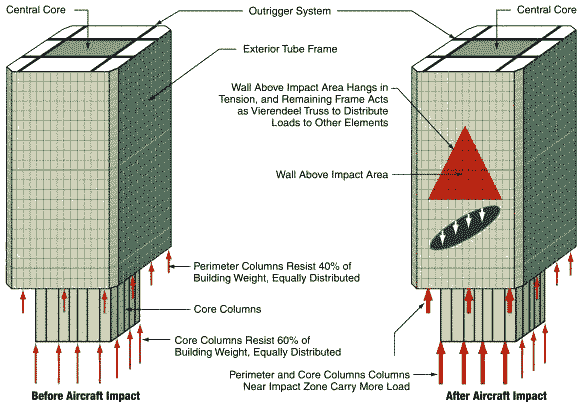
Figure 2-19 Redistribution of load after aircraft impact.
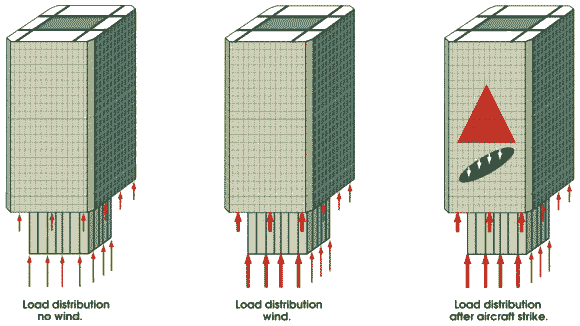
The resulting load distribution after the aircraft impact would have been almost identical to the load distribution incurred by strong wind from the back (i.e., from behind the plane of the page) as in the above graphic. Following the aircraft impact into the building, the structure was able to successfully redistribute the building weight to the remaining elements and to maintain a stable condition. This return to a stable condition is suggested by the preliminary analyses and also evidenced by the fact that the structure remained standing for 1 hour and 43 minutes following the impact. However, the structure's global strength was severely degraded. Although the structure may have been able to remain standing in this weakened condition for an indefinite period, it had limited ability to resist additional loading and could potentially have collapsed as a result of any severe loading event, such as that produced by high winds or earthquakes. WTC 1 probably experienced some additional loading and damage due to the collapse of the adjacent WTC 2. The extent of such damage is not known but likely included broken window and facade elements along the south face. This additional damage was not sufficient to cause collapse. The first event of sufficient severity to cause collapse was the fires that followed the aircraft impact.
2.2.1.2 Fire Development
It is estimated, based on information compiled from Government sources, that each aircraft contained about 10,000 gallons of jet fuel upon impact into the buildings. A review of photographic and video records show that the aircraft fully entered the buildings prior to any visual evidence of flames at the exteriors of the buildings. This suggests that, as the aircraft crashed into and plowed across the buildings, they distributed jet fuel throughout the impact area to form a flammable «cloud.» Ignition of this cloud resulted in a rapid pressure rise, expelling a fuel rich mixture from the impact area into shafts and through other openings caused by the crashes, resulting in dramatic fireballs.
Although only limited video footage is available that shows the crash of American Airlines Flight 11 into WTC 1 and the ensuing fireballs, extensive video records of the impact of United Airlines Flight 175 into WTC 2 are available. These videos show that three fireballs emanated from WTC 2 on the south, east, and west faces. The fireballs grew slowly, reaching their full size after about 2 seconds. The diameters of the fireballs were greater than 200 feet, exceeding the width of the building. Such fireballs were formed when the expelled jet fuel dispersed and flames traveled through the resulting fuel/air mixture. Experimentally based correlations for similar fireballs (Zalosh 1995) were used to estimate the amount of fuel consumed. The precise size of the fireballs and their exact shapes are not well defined; therefore, there is some uncertainty associated with estimates of the amount of fuel consumed by these effects. Calculations indicate that between 1,000 and 3,000 gallons of jet fuel were likely consumed in this manner. Barring additional information, it is reasonable to assume that an approximately similar amount of jet fuel was consumed by fireballs as the aircraft struck WTC 1.
